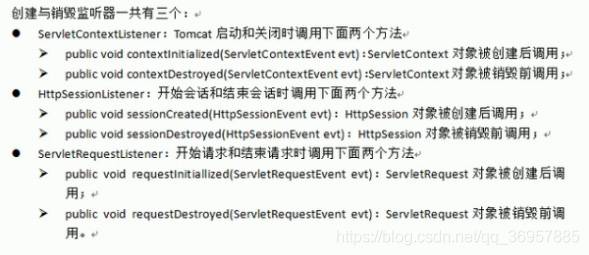这篇“如何使用HttpSessionListener监听器”文章的知识点大部分人都不太理解,所以小编给大家总结了以下内容,内容详细,步骤清晰,具有一定的借鉴价值,希望大家阅读完这篇文章能有所收获,下面我们一起来看看这篇“如何使用HttpSessionListener监听器”文章吧。
package lee;
import javax.servlet.*;
import javax.servlet.annotation.*;
import javax.servlet.http.*;import java.util.*;
@WebListener
public class OnlineListener
implements HttpSessionListener
{
// 当用户与服务器之间开始session时触发该方法
public void sessionCreated(HttpSessionEvent se)
{
HttpSession session = se.getSession();
ServletContext application = session.getServletContext();
// 获取session ID
String sessionId = session.getId();
// 如果是一次新的会话
if (session.isNew())
{
String user = (String)session.getAttribute("user");
// 未登录用户当游客处理
user = (user == null) ? "游客" : user;
Map<String , String> online = (Map<String , String>)
application.getAttribute("online");
if (online == null)
{
online = new Hashtable<String , String>();
}
// 将用户在线信息放入Map中
online.put(sessionId , user);
application.setAttribute("online" , online);
}
}
// 当用户与服务器之间session断开时触发该方法
public void sessionDestroyed(HttpSessionEvent se)
{
HttpSession session = se.getSession();
ServletContext application = session.getServletContext();
String sessionId = session.getId();
Map<String , String> online = (Map<String , String>)
application.getAttribute("online");
if (online != null)
{
// 删除该用户的在线信息
online.remove(sessionId);
}
application.setAttribute("online" , online);
}
}<%@ page contentType="text/html; charset=GBK" language="java" errorPage="" %>
<%@ page import="java.util.*" %>
<!DOCTYPE html PUBLIC "-//W3C//DTD XHTML 1.0 Transitional//EN"
"http://www.w3.org/TR/xhtml1/DTD/xhtml1-transitional.dtd">
<html xmlns="http://www.w3.org/1999/xhtml">
<head>
<title> 用户在线信息 </title>
<meta name="website" content="http://www.crazyit.org" />
</head>
<body>
在线用户:
<table width="400" border="1">
<%
Map<String , String> online = (Map<String , String>)application
.getAttribute("online");
for (String sessionId : online.keySet())
{%>
<tr>
<td><%=sessionId%>
<td><%=online.get(sessionId)%>
</tr>
<%}%>
</body>
</html>

应用场景:用来统计当前在线人数
import javax.servlet.ServletContext;
import javax.servlet.http.HttpSession;
import javax.servlet.http.HttpSessionEvent;
import javax.servlet.http.HttpSessionListener;
public class MyHttpSessionListener implements HttpSessionListener {
@Override
public void sessionCreated(HttpSessionEvent httpSessionEvent) {
System.out.println("httpsession被创建");
}
@Override
public void sessionDestroyed(HttpSessionEvent httpSessionEvent) {
System.out.println("httpsession被销毁");
}
}<%@ page contentType="text/html;charset=UTF-8" language="java" %> <html> <head> <title>$Title$</title> </head> <body> <% <%-- 创建HttpSessionListenter--%> request.getSession(); %> </body> </html>
<%@ page contentType="text/html;charset=UTF-8" language="java" %> <html> <head> <title>$Title$</title> </head> <body> <% <%-- 销毁HttpSessionListener--%> request.getSession().invalidate(); %> <h2>已退出</h2> </body> </html>
web.xml中配置监听
<?xml version="1.0" encoding="UTF-8"?> <web-app xmlns="http://xmlns.jcp.org/xml/ns/javaee" xmlns:xsi="http://www.w3.org/2001/XMLSchema-instance" xsi:schemaLocation="http://xmlns.jcp.org/xml/ns/javaee http://xmlns.jcp.org/xml/ns/javaee/web-app_4_0.xsd" version="4.0"> <listener> <listener-class>MyHttpSessionListener</listener-class> </listener> <listener> <listener-class>myServletContextListener</listener-class> </listener> </web-app>
因为HttpSessionListener监听器只在当前会话中有效
(1)创建ServletContextListener监听器并设置初始值为0
import javax.servlet.ServletContext;
import javax.servlet.ServletContextEvent;
import javax.servlet.ServletContextListener;
public class myServletContextListener implements ServletContextListener {
@Override
public void contextInitialized(ServletContextEvent servletContextEvent) {
ServletContext sc = servletContextEvent.getServletContext();
sc.setAttribute("count", 0);
}
@Override
public void contextDestroyed(ServletContextEvent servletContextEvent) {
}
}2)变更在线人数
import javax.servlet.ServletContext;
import javax.servlet.http.HttpSession;
import javax.servlet.http.HttpSessionEvent;
import javax.servlet.http.HttpSessionListener;
public class MyHttpSessionListener implements HttpSessionListener {
@Override
public void sessionCreated(HttpSessionEvent httpSessionEvent) {
System.out.println("httpsession被创建");
countPersion( httpSessionEvent.getSession().getServletContext(), true);
}
@Override
public void sessionDestroyed(HttpSessionEvent httpSessionEvent) {
System.out.println("httpsession被销毁");
countPersion(httpSessionEvent.getSession().getServletContext(), false);
}
/*
* 变更在线的人数
* */
public void countPersion(ServletContext sc, boolean isAdd) {
// 为了防止多线程并发问题加锁
synchronized (sc) {
// 获得当前的在线人数
Integer count = (Integer) sc.getAttribute("count");
if(isAdd) {
sc.setAttribute("count", ++count);
} else {
sc.setAttribute("count", --count);
}
}
}
}(3)前端页面上去获取显示
<%@ page contentType="text/html;charset=UTF-8" language="java" %>
<html>
<head>
<title>$Title$</title>
</head>
<body>
<%
<%-- 创建HttpSessionListenter--%>
request.getSession();
%>
<h2>欢迎登陆</h2>
<hr>
当前的在线人数 ${count}
<a href="logout.jsp" rel="external nofollow" >退出</a>
</body>
</html>以上就是关于“如何使用HttpSessionListener监听器”这篇文章的内容,相信大家都有了一定的了解,希望小编分享的内容对大家有帮助,若想了解更多相关的知识内容,请关注亿速云行业资讯频道。
免责声明:本站发布的内容(图片、视频和文字)以原创、转载和分享为主,文章观点不代表本网站立场,如果涉及侵权请联系站长邮箱:is@yisu.com进行举报,并提供相关证据,一经查实,将立刻删除涉嫌侵权内容。